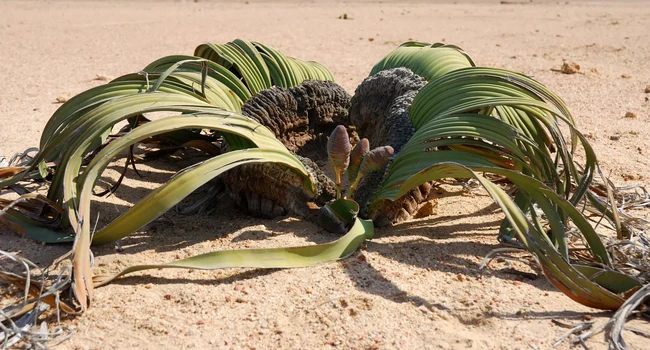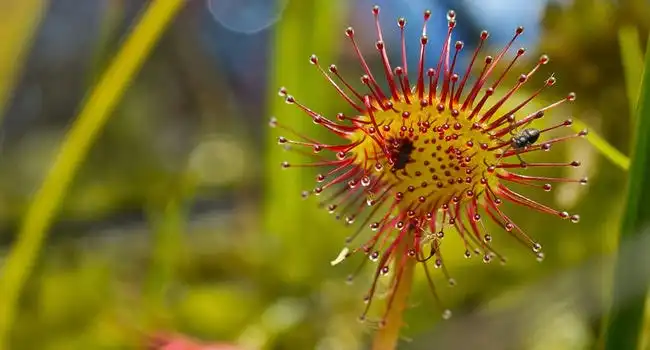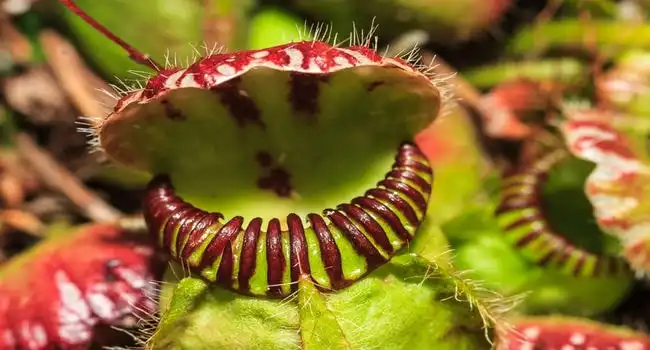In the fascinating realm of botany, a plethora of unique plants defy our conventional understanding of plant biology, captivating both experts and enthusiasts alike. These plants, ranging from the desiccation-resistant Resurrection Plant to the enigmatic Ghost Orchid, employ extraordinary survival strategies, display rare feeding mechanisms, and form intricate symbiotic relationships. As we journey through this curated list of the top 10 unique plants, we’ll delve into the compelling science behind these botanical marvels, each offering invaluable insights into the complexities of plant adaptation, evolution, and ecology.
10- Resurrection Plan

Photo Credit: The Spruce
The Resurrection Plant provides a captivating example of plant adaptation to extreme environmental conditions. Native to the arid regions of the Chihuahuan Desert, this unique plant has developed an extraordinary capability to survive prolonged periods of desiccation. When water is scarce, its leaves curl inward, transforming the plant into a dormant, ball-like structure that can withstand extreme dehydration. This desiccated state can be maintained for years until water becomes available. Upon rehydration, the plant “resurrects,” unfurling its leaves and resuming normal metabolic functions. Its unique ability to recover from near-death experiences makes it a subject of intense study in the fields of botany and molecular biology. Researchers are particularly interested in its cellular mechanisms, which could provide insights into drought resistance. This unique plant’s survival techniques have even inspired biotechnological applications aimed at improving crop resilience.
9- Venus Flytrap

Photo Credit: DNA India
Native to the subtropical wetlands along the East Coast of the United States, the Venus Flytrap presents one of the most intriguing feeding mechanisms in the plant kingdom. This carnivorous unique plant employs a set of specialized leaves that act as traps. These traps contain hair-like triggers that, when touched, activate the rapid closure of the leaf, ensnaring insects within. The trapped insects are then digested by enzymes, providing the plant with essential nutrients not readily available in its natural habitat’s soil. The Venus Flytrap’s adaptational journey into carnivory intrigues botanists and ecologists alike. Its unique feeding mechanism represents a remarkable example of evolutionary innovation, enabling the plant to thrive in nutrient-poor environments.
8- Corpse Flower

Photo Credit: Discovery
The Corpse Flower, native to the rainforests of Sumatra in Indonesia, is renowned for its gigantic inflorescence and pungent smell, which resembles rotting meat. This unique plant can grow up to 10 feet tall and produces a single, large flower that may take many years to bloom. The nauseating smell serves a critical purpose: it attracts carrion flies, which are essential for its pollination. The inflorescence comprises a spadix and a spathe, which unfurl to reveal a deep red interior. This visual and olfactory mimicry of decaying flesh is a fascinating adaptation strategy that has captured the attention of botanists worldwide. Due to its irregular blooming cycle and the spectacle it creates, it’s often a celebrated event when one of these unique plants comes to flower.
7- Lithops

Photo Credit: Mountain Crest Gardens
The Lithops species, commonly known as “Living Stones,” are native to the arid regions of southern Africa. These small, unique plants have adapted to their environment in a remarkable way: they mimic the appearance of the stones and rocks among which they grow. This camouflage helps them avoid predation. Each Lithops plant comprises mainly two fleshy, water-storing leaves and a root system. During periods of rainfall, the plant produces a colorful, daisy-like flower that emerges from the cleft between the leaves. The plant’s capacity to store water in its leaves enables it to survive long droughts, making it a marvel of adaptational biology.
6- Rafflesia Arnoldii

Photo Credit: Zigya
Found in the rainforests of Southeast Asia, Rafflesia arnoldii produces the largest individual flower in the world. This parasitic unique plant lacks traditional plant structures like leaves, stems, and roots, relying instead on its host plant for nutrients and water. The flower can grow up to three feet in diameter and emits a foul odor that mimics rotting meat, serving to attract flies for pollination. The flower consists of a complex array of chambers housing its reproductive organs. This intricate structure and its parasitic lifestyle make Rafflesia arnoldii a particularly interesting subject for botanists. Its unique attributes contribute to ongoing discussions about plant evolution, parasitism, and reproductive strategies.
5- Welwitschia Mirabilis

Photo Credit: Britannica
Welwitschia mirabilis stands as a botanical marvel native to the Namib Desert, one of the oldest and driest deserts in the world. This unique plant consists of only two leaves, a stem base, and a deep taproot. Remarkably, the two leaves continue to grow throughout the life of the plant, which can span over a thousand years. Due to harsh desert winds and environmental conditions, the leaves often become frayed and split, giving the illusion of multiple leaves. The plant has gender-specific cones, with male cones producing pollen and female cones producing seeds. This dioecious nature is relatively rare in plants, adding another layer of uniqueness. Water absorption mainly happens through dew or infrequent rainfall, which the taproot efficiently captures. Scientists and botanists find Welwitschia mirabilis fascinating for its longevity and its unique ability to adapt to one of the most inhospitable climates on Earth.
4- Sensitive Plant

Photo Credit: Wikimedia
Mimosa pudica, commonly known as the Sensitive Plant, fascinates botanists with its rapid leaf-folding response to touch. Native to Central and South America, this unique plant has pinnate leaves that collapse inward when stimulated. This rapid movement is facilitated by a change in cell pressure in the base of the leaves, a phenomenon known as “thigmonasty.” The leaf-folding mechanism serves multiple purposes: it deters herbivores, shakes off harmful insects, and minimizes water loss by reducing the leaf’s surface area exposed to the sun. The plant also exhibits a unique ability to grow in nitrogen-poor soils, thanks to a symbiotic relationship with nitrogen-fixing bacteria in its roots. This allows the Sensitive Plant to colonize and thrive in less competitive environments, making it a species of interest for studies in plant ecology, physiology, and biochemistry.
3- Sundew

Photo Credit: BBC
The Sundew genus encompasses a wide range of carnivorous plants that attract, capture, and digest insects. Found primarily in nutrient-poor environments like bogs and fens, these unique plants supplement their diet through carnivory. The leaves of Sundews are covered in specialized glandular trichomes that secrete a sticky, mucilaginous substance. When an insect lands on the leaf, it becomes ensnared in this sticky secretion. Enzymes are then secreted to digest the insect, breaking it down into nutrients that the plant can absorb. What makes the Sundew particularly captivating is its ability to move its leaves slowly to further entangle its prey, maximizing nutrient absorption.
2- Australian Pitcher Plant

Photo Credit: Learn About Nature
The Australian Pitcher Plant is a carnivorous plant indigenous to the southwestern regions of Australia. Unlike most plants that rely solely on photosynthesis for their energy needs, this unique plant derives nutrients by trapping and digesting insects. It accomplishes this by using modified leaves shaped like pitchers, filled with digestive enzymes. Insects are attracted to the pitcher by its color and the nectar it secretes. Once inside, they slip on the pitcher’s slick inner surface and fall into the digestive liquid at the bottom. The plant’s ability to produce enzymes capable of breaking down complex organic matter makes it a subject of scientific intrigue. Its unique adaptations to nutrient-poor environments have led to studies examining the potential for biotechnological applications, such as enzyme production for industrial use.
1- Ghost Orchid

Photo Credit: Fox 4 Now
The Ghost Orchid is one of the most enigmatic and elusive flowers in the plant kingdom. Native to the swamps and humid forests of Florida and Cuba, this unique plant lacks leaves and chlorophyll, the pigment responsible for photosynthesis in most plants. Instead, it relies on a symbiotic relationship with mycorrhizal fungi to obtain the nutrients and water it needs. The Ghost Orchid produces a rare and beautiful white flower that appears to float in mid-air, giving it its ethereal name. Its roots attach themselves to the host tree, and from these roots, a flower stalk emerges, leading to the spectacular, albeit rare, blooming event that can happen at any time of the year but is most common during the summer months.
Pollination of the Ghost Orchid is equally fascinating, being carried out by the Giant Sphinx Moth, one of the few creatures with a long enough proboscis to access the flower’s nectar. The orchid and the moth have evolved together in a delicate ecological dance that captivates botanists and ecologists alike. The plant’s dependence on a specific pollinator and its unique symbiotic relationship with fungi make it a subject of extensive research, particularly in the fields of plant ecology, co-evolution, and conservation biology.


